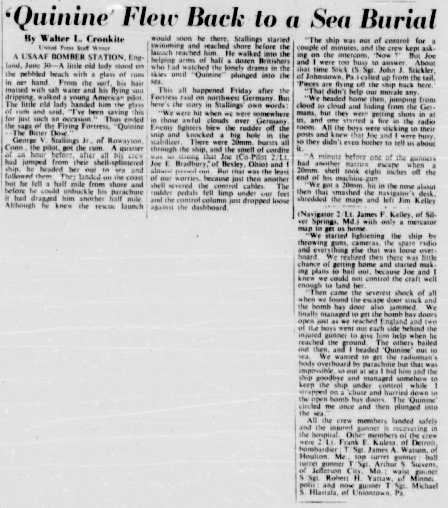
'Quinine' Flew Back to a Sea Burial
By Walter L. Cronkite
United Press Staff Writer
A USAAF Bomber Station,
England, June 30----
A little old lady stood on
the pebbled beach with a glass of rum in her hand. From the surf, his
hair matted with salt water and his flying suit dripping, walked a young
American pilot. The little old lady handed him the glass of rum and
said, "I've been saving this for just such an occasion". Thus ended
the saga of the Flying Fortress, "Quinine----The Bitter Dose".
George V. Stallings Jr, of Rowayton, Conn., the pilot,
got the rum. A quarter of an hour before, after all his crew had jumped
from their shell-splatered ship, he headed her out to sea and followed
them. They landed on the coast but he fell a half mile from shore
and before he could unbuckle his parachute it had dragged him another half
mile. Although he knew the rescue launch would soon be there, Stallings
started swimming and reached shore before the launch reached him.
He walked into the helping arms of half a dozen Britishers who had watched
the lonely drama in the skies until 'Quinine' plunged into the sea.
This all happened Friday after the Fortress
raid on northwest Germany. But here's the story in Stalling's own
words:
" We were hit when we were somewhere in those awful
clouds over Germany. Enemy fighters blew the rudder off the ship
and knocked a big hole in the stabilizer. There were 20mm bursts
all through the ship, and the smell of cordite was so strong that Joe (Co-Pilot
2/Lt Joe E. Bradbury, of Besley, Ohio) and I almost passed out. But that
was the least of our worries, because just then another shell severed the
control cables. The rudder pedals fell limp under our feet and the
control column just dropped loose against the dashboard.
The ship was out of control for a couple of
minutes, and the crew kept asking on the intercom, 'Now?' But Joe
and I were too busy to answer. About that time Stick (S/Sgt John J. Stickler,
of Johnstown, Pa) called up from the tail, 'Pieces are flying off the ship
back here.' "That didn't help our morale any. We headed home then, jumping
from cloud to cloud and hiding from the Germans, but they were getting
shots in at us, and one started a fire in the radio room. All the
boys were sticking to their posts and knew that Joe and I were busy, so
they didn't even bother to tell us about it.
"A minute before, one of the gunners had another narrow
excape when a 20mm shell took eight inches off the end of his machine gun.
"We got a 20mm hit in the nose about then that smashed
the navigator's desk, shredded the maps and left Jim Kelley (Navigator
2/Lt James F. Kelley of Silver Springs, Md.) with only a mercator map to
get us home.
"We started lightening the ship by throwing guns,
cameras, the spare radio and everything else that was loose overboard.
We realized then there was little chance of getting home and started making
plans to bail out, because Joe and I knew we could not control the craft
well enough to land her.
"Then came the severest shock of all when we found the
escape door stuck and the bomb bay door also jammed. We finally managed
to get the bomb bay doors open just as we reached England and two of the
boys went out each side behind the injured gunner to give him help when
he reached the ground. The others bailed out then, and I headed 'Quinine'
out to sea. We wanted to get the radioman's body overboard by parachute
but that was impossible, so out at sea I bid him and the ship goodbye and
managed somehow to keep the ship under control while I strapped on a 'chute
and hurried down to the open bomb bay doors. The 'Quinine' circled
me once and then plunged into the sea."
All the crew members landed safely and the injured gunner
is recovering in the hospital. Other members of the crew were 2/Lt
Frank E Kulesa of Detroit, bombardier; T/Sgt James A Watson of Houlton,
Me, top turret gunner; ball turret gunner T/Sgt. Arthur S. Stevens, of
Jefferson City, Mo.; waist gunner S/Sgt Robert H. Yattaw, of Minneapolis;
and nose gunner T/Sgt Michael S. HLastala, of Uniontown, Pa.